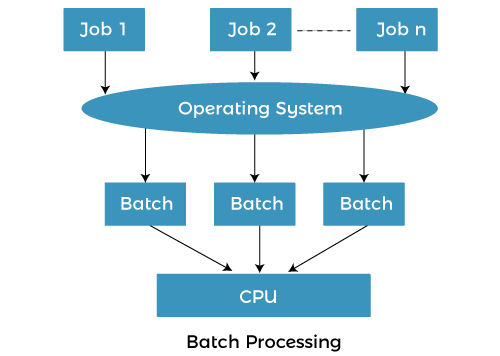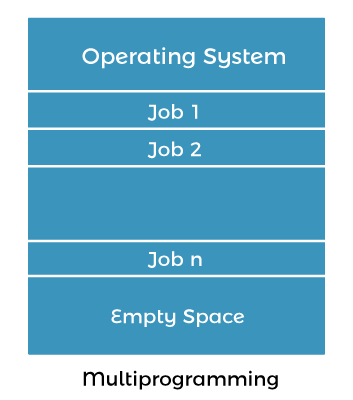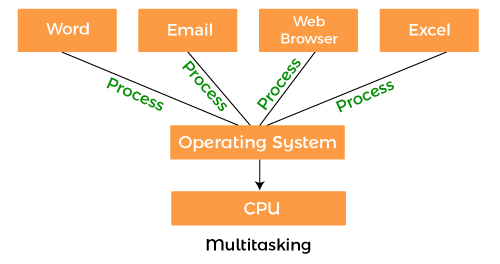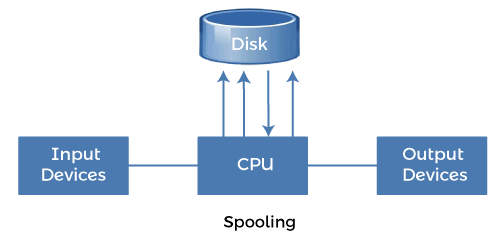Properties of Operating SystemThe OS is an interface that makes things simpler for the users. It provides the services to both the user and the system to make the interaction between them. It also has various properties. These OS properties are more likes the tasks performed by an OS than a feature that makes the system user-friendly. In this article, you will learn the properties of the operating system. Properties of Operating SystemHere, you will learn about the properties of the operating system. There are various properties of the operating system. Some of the OS properties are as follows:
Batch ProcessingThe batch processing system work as an operating system. It refers to a system that collects all types of programs and data in a batch form and then processes them. The primary goal of a batch processing system is to reduce setup time while submitting similar jobs to the CPU. 
It was also used in the hard disk and card readers. All jobs are stored on the hard disk in order to create a pool of jobs for batch execution. After reading the pooled jobs, the batch monitor is launched to execute them. These jobs are sorted into groups, and then the same jobs are assigned to a similar batch. Now, all batched operations are ready to be executed one by one without wasting any more time. It improves system utilization while decreasing the turnaround time. All jobs and processes are running in the "First Come First Serve" manner. When a job is finished with its processing, its memory is free, and the results are copied to an output spool for further printing or processing. Advantages and Disadvantages of Batch ProcessingThere are various advantages and disadvantages of batch processing. The advantages and disadvantages of batch processing are as follows: Advantages
Disadvantages
MultiprogrammingMultiple programs may be loaded into the main memory for execution in a multiprogramming system. Only one program or process may use the CPU to execute instructions simultaneously, while others must wait for their time. The main goal of using a multiprogramming system is to overcome the underutilization of the CPU and primary memory and manage the entire system's resources. The main components of a multiprogramming system are the I/O control system, command processor, transient area, and file system. 
Moreover, these systems are designed based on sub-segmenting parts of the transitory area to store the separate programs. The resource management routines are connected to the OS's important functions. Advantages and Disadvantages of MultiprogrammingThere are various advantages and disadvantages of multiprogramming. The advantages and disadvantages of multiprogramming are as follows: Advantages
Disadvantages
InteractivityInteractivity refers to a user's ability to interact with a system. The operating system offers a user interface for interacting with the system, handles the input/output devices, and ensures a short response time. Advantages and Disadvantages of InteractivityThere are various advantages and disadvantages of interactivity. The advantages and disadvantages of the interactivity are as follows: Advantages
Disadvantages
Real-Time SystemIt is generally dedicated as an embedded system. The OS reads and reacts via the sensor data and provides a response in a predetermined time frame to ensure proper performance. Advantages and Disadvantages of Real-Time SystemThere are various advantages and disadvantages of the Real-Time system. The advantages and disadvantages of the real-time system are as follows: Advantages
Disadvantages
Distributive EnvironmentA distributed environment is a collection of multiple independent processors or CPUs within a single computer system. The operating system controls the interaction between physical processors and distributes processing logic among them. Instead of sharing a memory or a clock, the CPUs each have their local memory. Advantages and Disadvantages of Distributive EnvironmentThere are various advantages and disadvantages of the Distributive Environment. The advantages and disadvantages of a distributive environment are as follows: Advantages
Disadvantages
Multitasking
A multitasking operating system provides an interface for a single user to execute many programs tasks on the same computer system at the same time. Multiple tasks are also referred to as processes that share common processing resources, such as a CPU. For example, any editing task may be executed while other programs are executing simultaneously, such as the user can open Gmail and PowerPoint same time. Advantages and Disadvantages of MultitaskingThere are various advantages and disadvantages of multitasking. The advantages and disadvantages of multitasking are as follows: Advantages
Disadvantages
SpoolingSpooling stands for Simultaneous Peripheral Operation Online. It's a buffer that holds jobs or tasks for a system until it's ready to receive or execute a new one. In spooling, a job's input/output is combined with another job's computation. For example, the spooler can read a job's input and print the result of another job at the same time. 
It may also process data in other locations. It requires being alerted when a remote-side process completes spooling another process to the remote-side device. Spooling improves the system performance by increasing the device's working rate. Advantages and Disadvantages of SpoolingThere are various advantages and disadvantages of Spooling. The advantages and disadvantages of spooling are as follows: Advantages
Disadvantages
Next TopicWhat is Processor Affinity
|
 For Videos Join Our Youtube Channel: Join Now
For Videos Join Our Youtube Channel: Join Now
Feedback
- Send your Feedback to [email protected]
Help Others, Please Share









